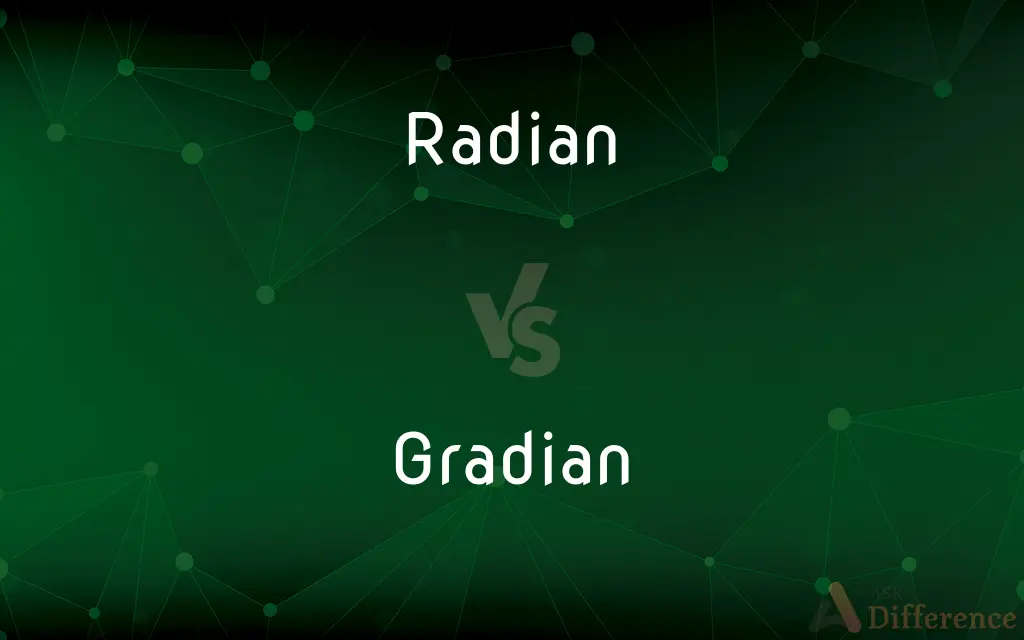Radian vs. Gradian — What's the Difference?
By Tayyaba Rehman & Fiza Rafique — Updated on March 7, 2024
Radian is a standard unit of angular measurement used in mathematics and physics. Gradian, also known as "gon", is a unit of angular measure where a right angle is divided into 100 parts.

Difference Between Radian and Gradian
Table of Contents
ADVERTISEMENT
Key Differences
Radian is defined based on the radius of a circle, where one radian is the angle created at the center of a circle by an arc whose length is equal to the radius of the circle. Gradian, on the other hand, is part of a metric system of angles where the whole circle is divided into 400 grads, making a right angle equal to 100 grads. Gradians are less common than radians and degrees, and they are primarily used in some fields like surveying and civil engineering.
When using radians, the measure of a full circle is 2π radians, which corresponds to approximately 6.283 radians. In the gradian system, a full circle is 400 grads, which makes calculations in some contexts simpler, particularly in surveying and where decimal subdivision is preferred. A right angle being 100 grads aligns neatly with the decimal system.
Radians are widely used in calculus and trigonometry because many mathematical formulas become simpler or more intuitive when angles are measured in radians. Gradians, while not as commonly used, offer an alternative that some find more intuitive for certain applications due to its alignment with the decimal system.
The derivative of the sine function is a cosine function when the angle is in radians, a simplicity not present with other units of measure. In gradian measure, a straight line is 200 grads, which might be considered more straightforward than the 180 degrees in the degree system.
Comparison Chart
Definition
The angle subtended at the center of a circle by an arc equal in length to the radius of the circle.
A unit of angular measurement where a full circle is divided into 400 parts.
ADVERTISEMENT
Circle Division
Full circle is 2π radians (approx. 6.283 radians).
Full circle is 400 grads.
Relation to Circle
Directly related to the radius and circumference of a circle.
Divides a circle into 400 parts, aligning with the decimal system.
Usage
Predominantly used in mathematics, physics, and engineering.
Used in some fields like surveying and civil engineering.
Calculations
Makes many mathematical formulas simpler, particularly in calculus and trigonometry.
Simplifies calculations in certain contexts, aligning with the decimal system.
Compare with Definitions
Radian
Used as the standard unit of angular measurement for trigonometric functions.
The sine of π/2 radians is 1.
Gradian
Used for measuring angles in land surveying and civil engineering.
A land plot might be described as having a boundary angle of 100 grads.
Radian
Commonly used to describe angular velocity and acceleration.
The angular velocity of a rotating object is often expressed in radians per second.
Gradian
Sometimes used in navigation to describe bearings.
A bearing of 200 grads could indicate a straight line in gradian measurement.
Radian
Facilitates the derivation and integration of trigonometric functions.
The derivative of sin(x) with respect to x is cos(x) when x is in radians.
Gradian
Employed in certain mapping and geographical information systems.
Gradian measurements might be used in specific GIS software for calculating angles on maps.
Radian
Applied in various calculations involving rotations and cycles.
Engineers use radians to calculate the stress in materials subjected to rotational forces.
Gradian
Taught as an alternative angular measurement system, aligning with the decimal system.
Some educational curriculums introduce grads to help students understand angular measurements.
Radian
A measure of angle defined by the length of an arc divided by the radius of the circle.
An angle of 1 radian results from an arc length equal to the radius of the circle.
Gradian
Offers a decimal-based approach to angular measurements in applicable mathematical problems.
When working with equations that benefit from decimal division, grads might be used for simplicity.
Radian
The radian, denoted by the symbol rad {\displaystyle {\text{rad}}} , is the SI unit for measuring angles, and is the standard unit of angular measure used in many areas of mathematics. The unit was formerly an SI supplementary unit (before that category was abolished in 1995) and the radian is now an SI derived unit.
Gradian
In trigonometry, the gradian, also known as the gon (from Ancient Greek: γωνία, romanized: gōnía, lit. 'angle'), grad, or grade, is a unit of measurement of an angle, defined as one hundredth of the right angle; in other words, there are 100 gradians in 90 degrees. It is equivalent to 1/400 of a turn, 9/10 of a degree, or π/200 of a radian.
Radian
A unit of angular measure equal to the angle subtended at the center of a circle by an arc equal in length to the radius of the circle, approximately 57°17′44.6".
Gradian
A unit of angle equal to 0.9 degrees, so that there are 100 gradians in a right angle.
Radian
(geometry) In the International System of Units, the derived unit of plane angular measure of angle equal to the angle subtended at the centre of a circle by an arc of its circumference equal in length to the radius of the circle. Symbol: rad
Radian
An arc of a circle which is equal to the radius, or the angle measured by such an arc.
Radian
The unit of plane angle adopted under the Systeme International d'Unites; equal to the angle at the center of a circle subtended by an arc equal in length to the radius (approximately 57.295 degrees)
Common Curiosities
How does the choice of angular measurement unit affect mathematical expressions?
The choice of unit can affect the simplicity and form of mathematical expressions, especially in trigonometry and calculus, where radians often result in simpler formulas.
How do you convert between radians and gradians?
To convert, use the relationship that 2π radians equal 400 grads. Therefore, 1 radian equals approximately 63.662 grads and 1 grad equals approximately 0.0157 radians.
Why are radians more commonly used than gradians?
Radians are more aligned with natural mathematical functions, particularly in calculus, making them the preferred choice in mathematics and sciences.
Can the use of gradians simplify calculations?
In certain contexts, especially where decimal division is advantageous, gradians can simplify calculations due to their alignment with the decimal system.
Are there situations where gradians are preferred over radians?
In surveying, civil engineering, and certain educational contexts, gradians may be preferred for their simplicity and alignment with the decimal system.
Why is a full circle measured as 2π radians?
This measurement comes from the circumference of a circle, which is 2π times the radius, making the angle around a circle 2π radians when the arc length equals the circumference.
How does the decimal system alignment of gradians benefit specific fields like surveying?
The alignment with the decimal system can make calculations, adjustments, and divisions more straightforward in fields that frequently involve numerical computations and measurements.
Are there tools or devices that specifically use gradians?
Certain tools, like some calculators and specialized surveying instruments, might have settings or modes that use gradians for measurements.
What impact does the choice of angular measurement have on teaching and learning geometry?
The choice of angular measurement can influence the complexity of mathematical concepts and how intuitively they can be understood, with radians often providing a deeper connection to mathematical principles.
Is one unit of angular measurement more accurate than the other?
Accuracy is not inherently dependent on the unit of measurement but on how precisely the measurement is made. Both radians and gradians can be used for precise measurements.
How do software and digital platforms handle different angular measurements?
Many software platforms, especially those involved in design, engineering, and mathematics, allow users to choose their preferred unit of angular measurement, including radians and gradians.
What historical factors have influenced the adoption of radians over gradians?
The adoption of radians is largely due to their mathematical properties and the historical development of calculus and trigonometry, where radians provide inherent advantages.
Can the use of different angular measurements lead to confusion in interdisciplinary contexts?
Yes, when professionals from different fields collaborate, the use of different angular measurements can lead to confusion, necessitating clear communication and possibly conversion between units.
What are the pedagogical arguments for teaching radians or gradians in education?
Teaching radians is often justified by their widespread use in higher mathematics and their natural relation to circle properties, while gradians may be introduced for their simplicity and alignment with the decimal system.
How does the use of radians or gradians affect international collaboration in science and engineering?
International standards and conventions, including the use of radians in scientific publications, help mitigate potential confusion in collaboration, though awareness of different units like gradians remains important.
Share Your Discovery

Previous Comparison
Revolve vs. Evolve
Next Comparison
Tiredly vs. WearilyAuthor Spotlight
Written by
Tayyaba RehmanTayyaba Rehman is a distinguished writer, currently serving as a primary contributor to askdifference.com. As a researcher in semantics and etymology, Tayyaba's passion for the complexity of languages and their distinctions has found a perfect home on the platform. Tayyaba delves into the intricacies of language, distinguishing between commonly confused words and phrases, thereby providing clarity for readers worldwide.
Co-written by
Fiza RafiqueFiza Rafique is a skilled content writer at AskDifference.com, where she meticulously refines and enhances written pieces. Drawing from her vast editorial expertise, Fiza ensures clarity, accuracy, and precision in every article. Passionate about language, she continually seeks to elevate the quality of content for readers worldwide.















































